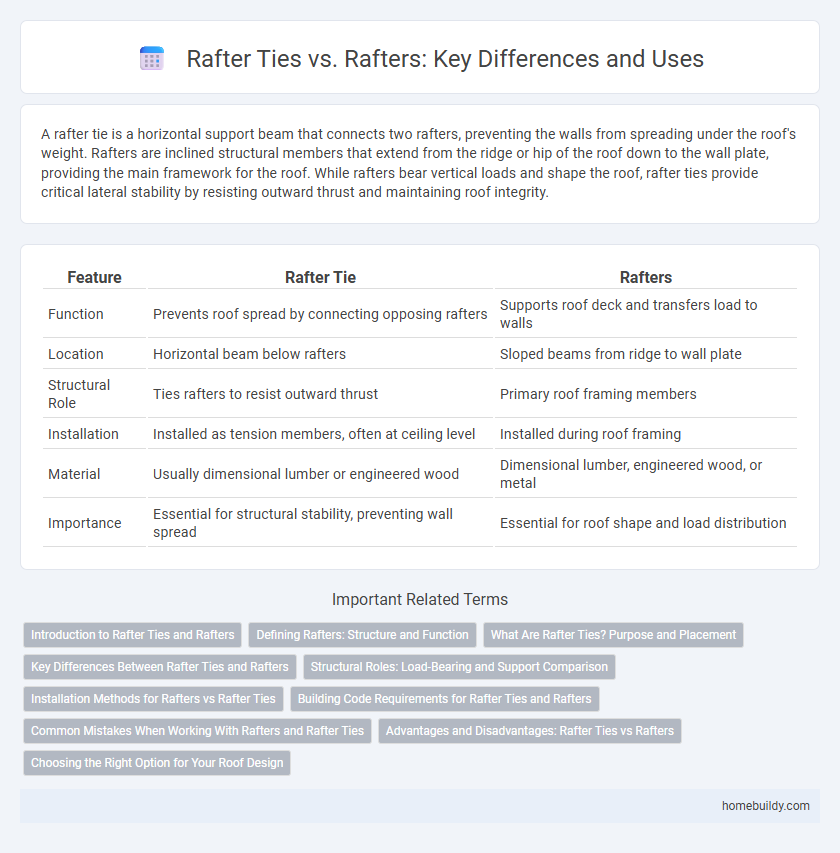A rafter tie is a horizontal support beam that connects two rafters, preventing the walls from spreading under the roof's weight. Rafters are inclined structural members that extend from the ridge or hip of the roof down to the wall plate, providing the main framework for the roof. While rafters bear vertical loads and shape the roof, rafter ties provide critical lateral stability by resisting outward thrust and maintaining roof integrity.
Table of Comparison
| Feature | Rafter Tie | Rafters |
|---|---|---|
| Function | Prevents roof spread by connecting opposing rafters | Supports roof deck and transfers load to walls |
| Location | Horizontal beam below rafters | Sloped beams from ridge to wall plate |
| Structural Role | Ties rafters to resist outward thrust | Primary roof framing members |
| Installation | Installed as tension members, often at ceiling level | Installed during roof framing |
| Material | Usually dimensional lumber or engineered wood | Dimensional lumber, engineered wood, or metal |
| Importance | Essential for structural stability, preventing wall spread | Essential for roof shape and load distribution |
Introduction to Rafter Ties and Rafters
Rafter ties are horizontal structural elements installed between opposing rafters to prevent roof spread and maintain stability under load. Rafters are the sloped beams that support the roof deck and transfer weight to the building's walls. Understanding the function of rafter ties versus rafters ensures proper roof framing and structural integrity in residential and commercial construction.
Defining Rafters: Structure and Function
Rafters are the sloped structural beams extending from the ridge or hip of a roof to the wall plate, supporting the roof deck and bearing the weight of roofing materials. They form the primary framework of a pitched roof, ensuring stability and load distribution across the building's structure. Unlike rafter ties, which connect opposing rafters to prevent outward spread, rafters primarily function to shape and support the roof's overall geometry.
What Are Rafter Ties? Purpose and Placement
Rafter ties are horizontal structural members installed between opposing rafters to prevent outward spread and provide stability to the roof framework. Unlike rafters, which form the sloped sides of the roof, rafter ties serve to resist tension forces, maintaining the integrity of the roof by securing the walls from bowing outward. Proper placement of rafter ties is typically near the ceiling level of the attic, ensuring effective load distribution and structural reinforcement.
Key Differences Between Rafter Ties and Rafters
Rafter ties are horizontal structural components designed to prevent roof spread by connecting opposing rafters, while rafters are inclined beams that form the main framework supporting the roof deck and load. The key difference lies in function: rafters bear vertical loads from roofing materials and snow, whereas rafter ties resist outward thrust and maintain wall stability. Rafter ties are typically installed at the ceiling level, creating a tension member that mitigates the risk of walls bowing outward due to roof forces.
Structural Roles: Load-Bearing and Support Comparison
Rafter ties primarily function as horizontal supports that prevent roof rafters from spreading under load, maintaining the structural integrity of the roof framework. Rafters, as inclined beams, bear the vertical loads from the roof covering and transfer them down to the walls or beams. Together, rafter ties and rafters distribute loads efficiently, with rafter ties counteracting outward thrust while rafters handle downward forces.
Installation Methods for Rafters vs Rafter Ties
Rafters are typically installed by securing them directly to the ridge board and wall plates using nails or metal connectors to form the roof framing. Rafter ties, installed horizontally between opposing rafters, require precise placement in the lower third of the roof structure to prevent outward wall thrust and are anchored with nails, screws, or metal straps for reinforcement. Proper installation methods for rafter ties ensure structural stability and resist roof spreading, differing from the vertical load-bearing focus of individual rafter installation.
Building Code Requirements for Rafter Ties and Rafters
Building codes mandate specific sizing and placement requirements for rafter ties to prevent roof uplift and maintain structural integrity. Rafters must be securely connected with rafter ties at specified intervals, typically at the lower third of the rafter span, to resist lateral forces and support loads according to standards such as the International Residential Code (IRC). Compliance with these codes ensures safety, durability, and performance in residential roof framing systems.
Common Mistakes When Working With Rafters and Rafter Ties
Common mistakes when working with rafters and rafter ties include improper placement of rafter ties too high on the rafters, which reduces their effectiveness in preventing roof spread. Using undersized or inadequate fasteners compromises the structural integrity and can lead to roof failure. Failing to install rafter ties at the correct intervals or neglecting to consult local building codes often results in weakened roof framing and costly repairs.
Advantages and Disadvantages: Rafter Ties vs Rafters
Rafter ties provide significant structural advantages by preventing outward thrust on walls, enhancing roof stability, and reducing the risk of wall spreading compared to rafters alone. However, rafters offer more straightforward installation and allow for greater ceiling height, though they may require additional support to avoid roof sagging. The choice between rafter ties and rafters hinges on balancing structural support needs with architectural design preferences.
Choosing the Right Option for Your Roof Design
Rafter ties provide crucial horizontal support, preventing walls from spreading under roof load, whereas rafters serve as the primary sloping beams that form the roof structure. Choosing the right option for your roof design depends on factors like span length, roof pitch, and load requirements, with rafter ties ideal for open attic spaces requiring tension support. Incorporating rafter ties enhances structural integrity, reduces the need for bulky interior walls, and supports code compliance in modern roofing systems.
Rafter tie vs Rafters Infographic

 homebuildy.com
homebuildy.com